Abstract
1. The circulatory and metabolic effects of temperature reduction were studied in autoperfused canine subcutaneous adipose tissue in situ. 2. Cooling the adipose tissue sufficiently to reduce venous effluent temperature by 5--6 degrees C decreased blood flow from an average of 6.4--4.1 ml. min-1 . 100g-1. 3. Vasoconstrictor responses to sympathetic nerve stimulation (4 HZ) and injected noradrenaline (5 n-mole) were potentiated by cooling while vasodilator components of the vascular responses, such as autoregulatory escape and post-stimulatory hyperaemia, were virtually abolished by this treatment. 4. Oxygen uptake was reduced by cooling without signs of tissue hypoxia. This reduced oxygen demand may partly cause the decrease in adipose tissue blood flow. 5. Cooling inhibited glycerol mobilization from the adipose tissue during sympathetic nerve stimulation. Post-stimulatory lipolysis was, however, not inhibited. In vitro studies with 'perifused' rat fat cells suggest that this may be due to impaired inactivation of the lipolytic process, rather than to changes in transmitter removal, following stimulation at low temperature. 6. Cooling inhibited the mobilization of fatty acids more than that of glycerol, suggesting increased re-esterification of fatty acids within the tissue at low temperature. 7. It is concluded that cooling increases the sensitivity to vasoconstrictor stimuli and that inhibition of metabolic vasodilator mechanisms play a role for this effect. The stimultaneous inhibition of activating and inactivating mechanisms could explain the unchanged vascular and lipolytic responses to brief stimuli. Some possible implications of the present findings for the physiology of adipose tissue during cooling are discussed.
Full text
PDF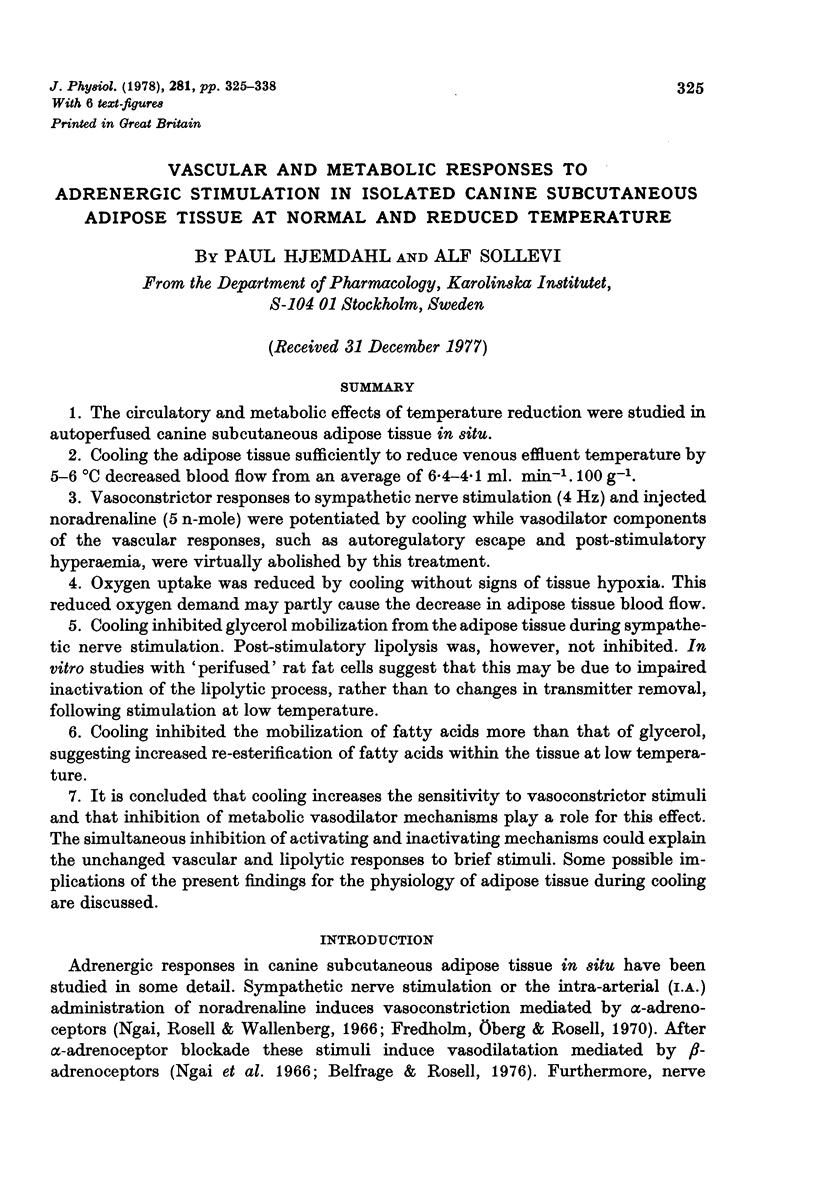
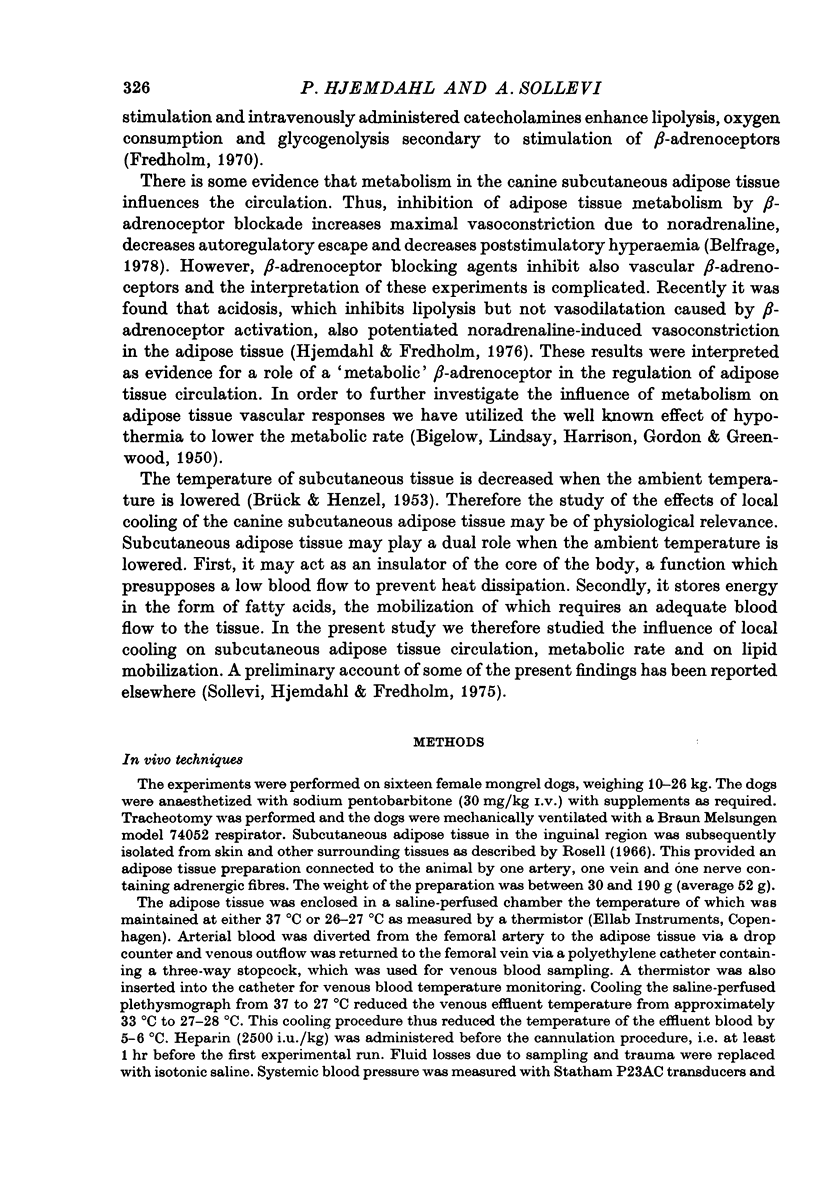

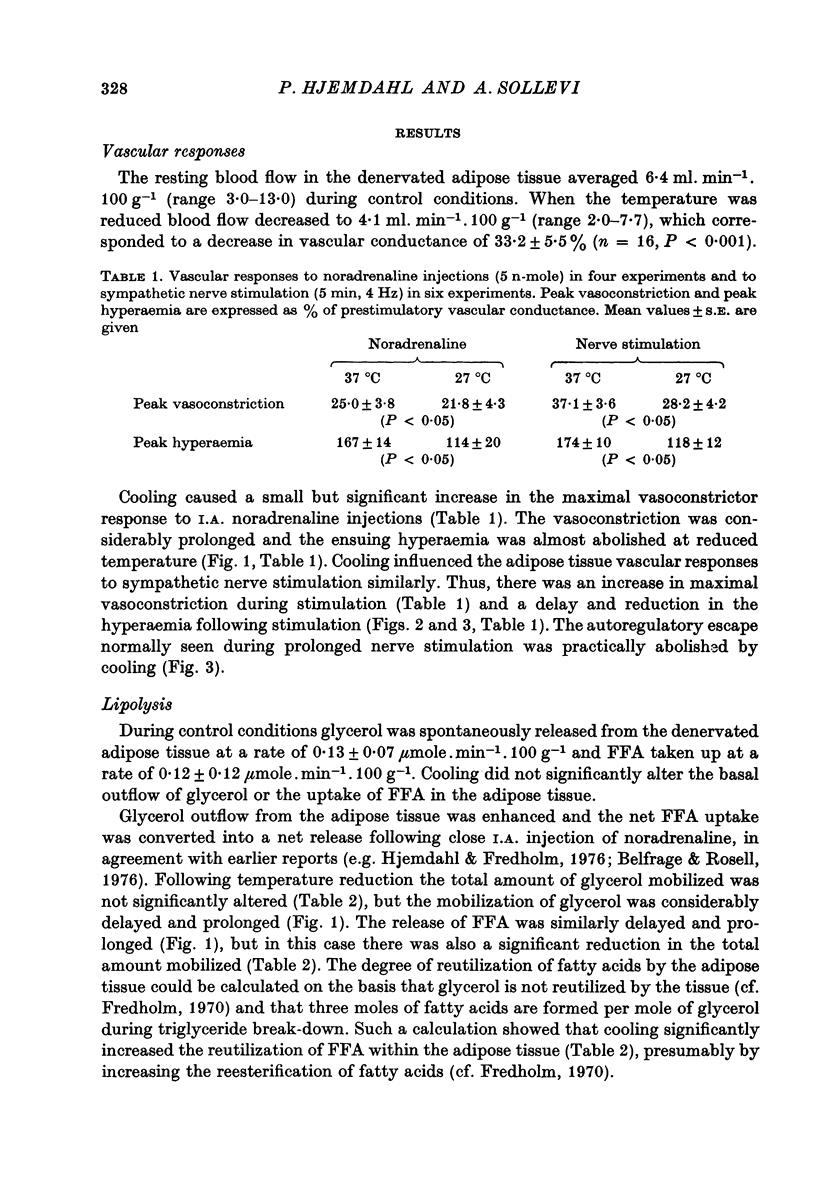
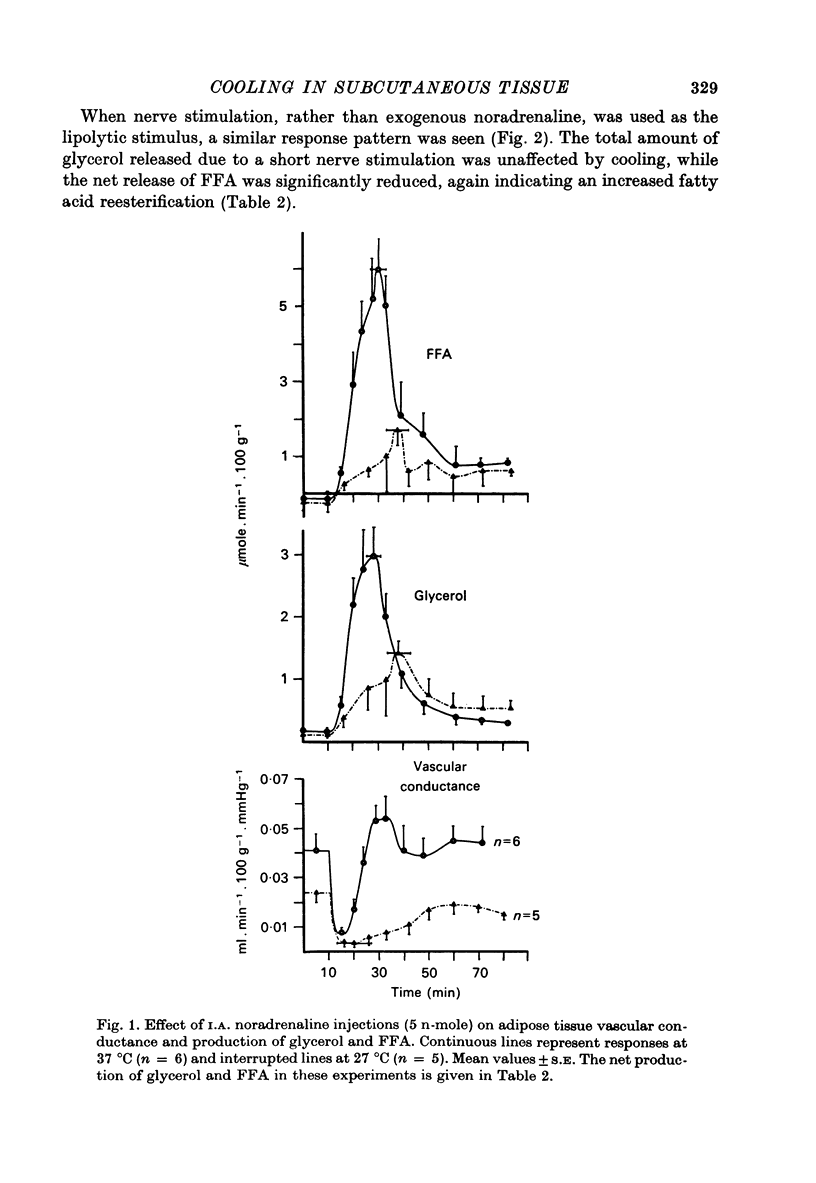
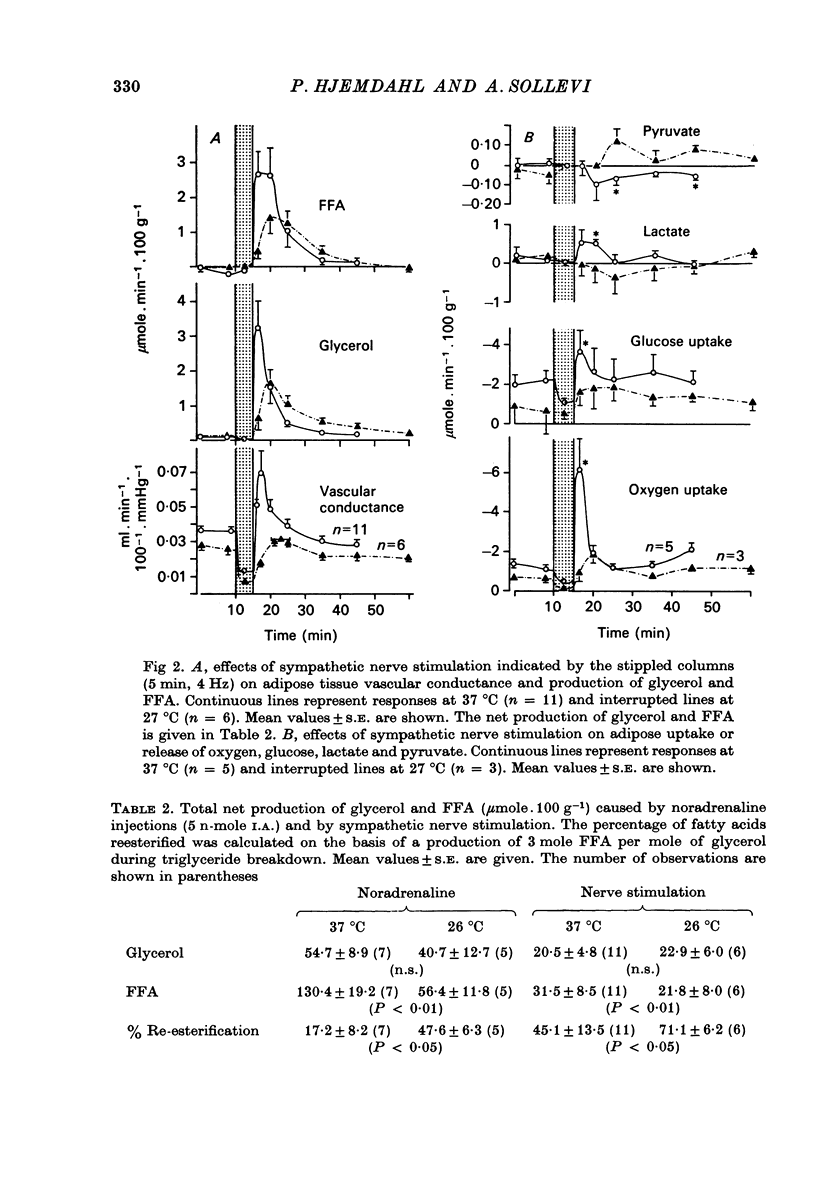
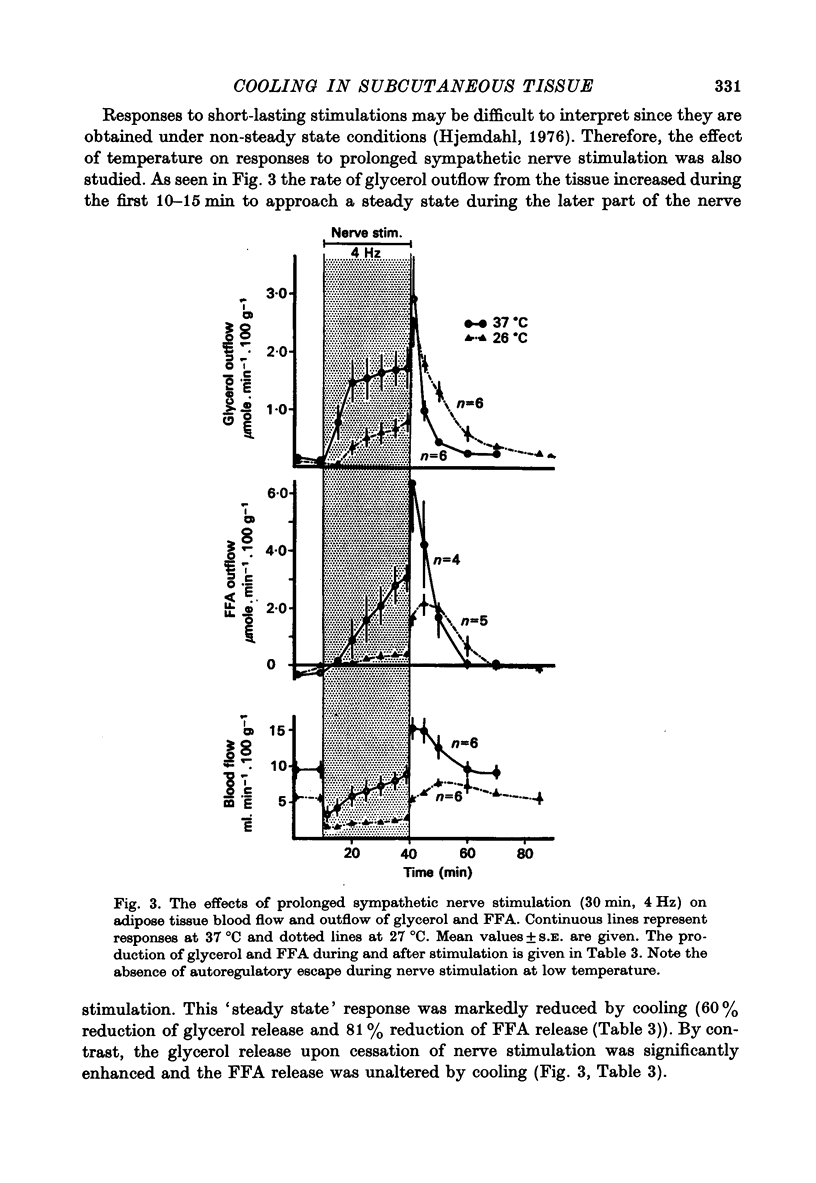
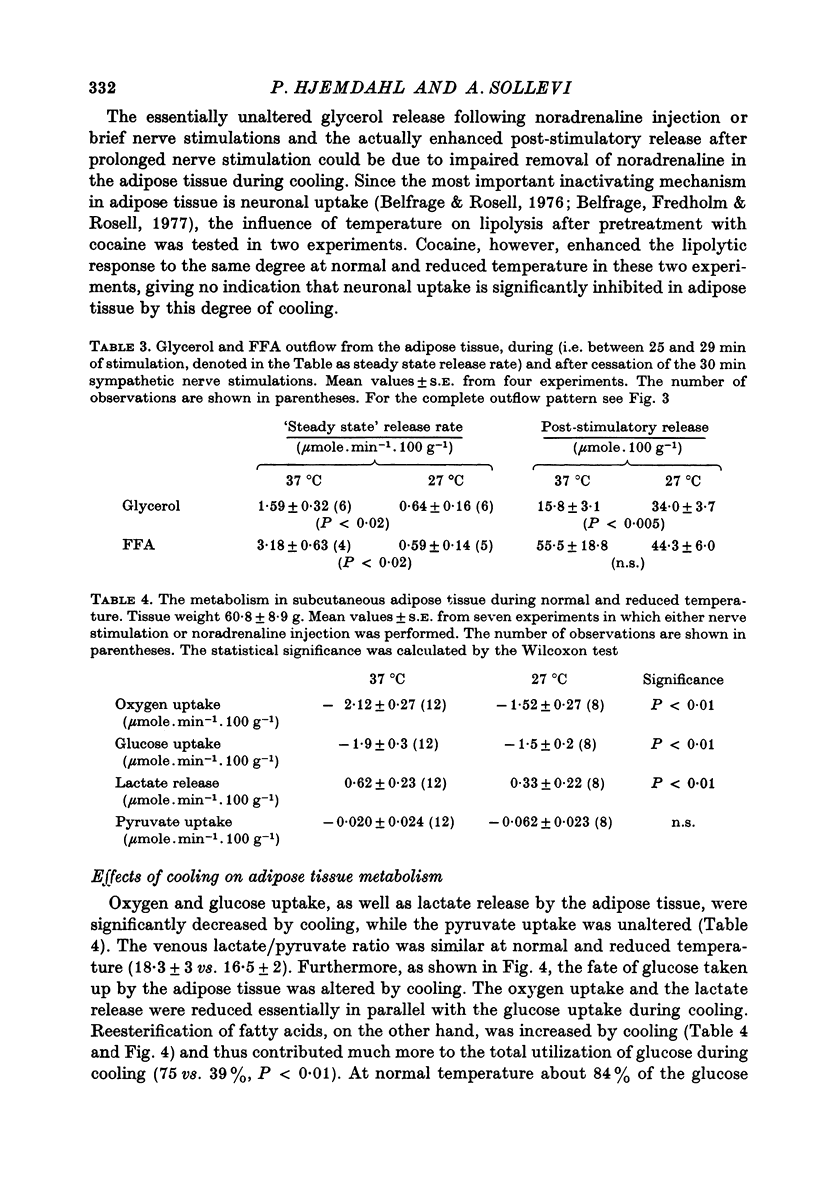
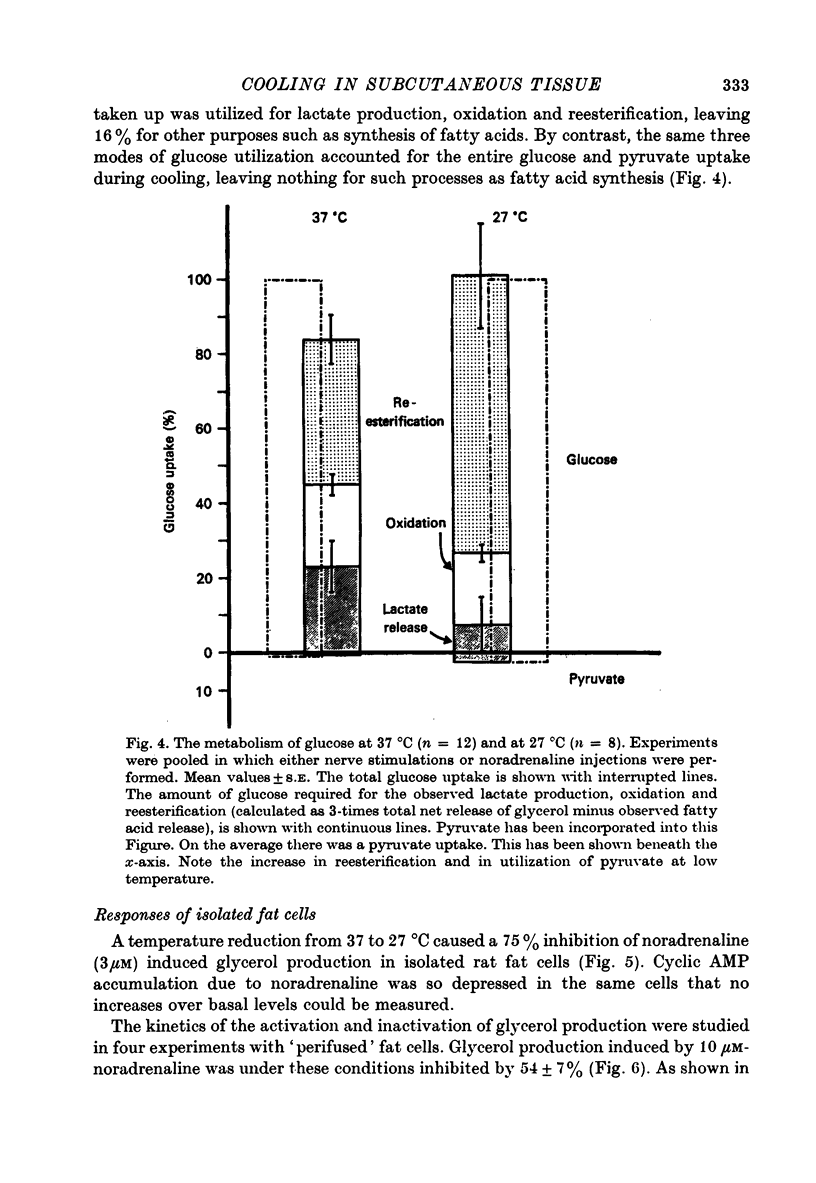
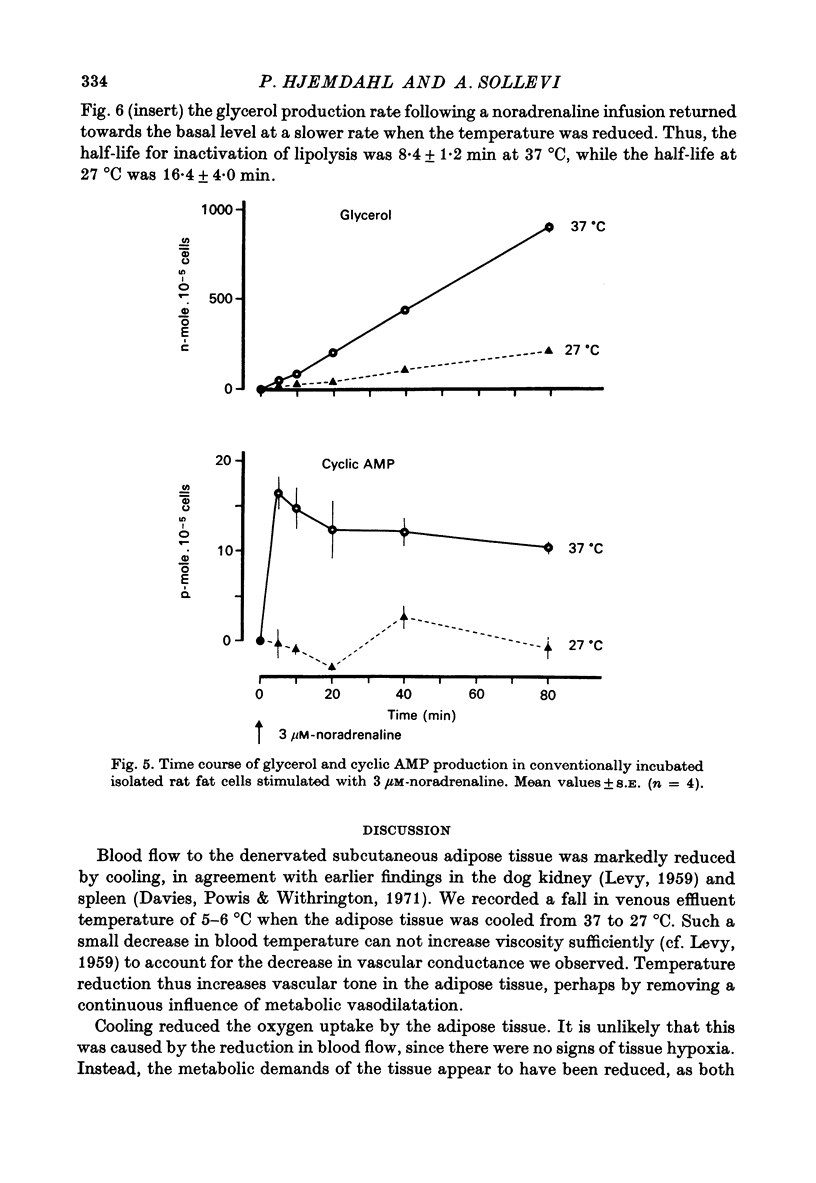
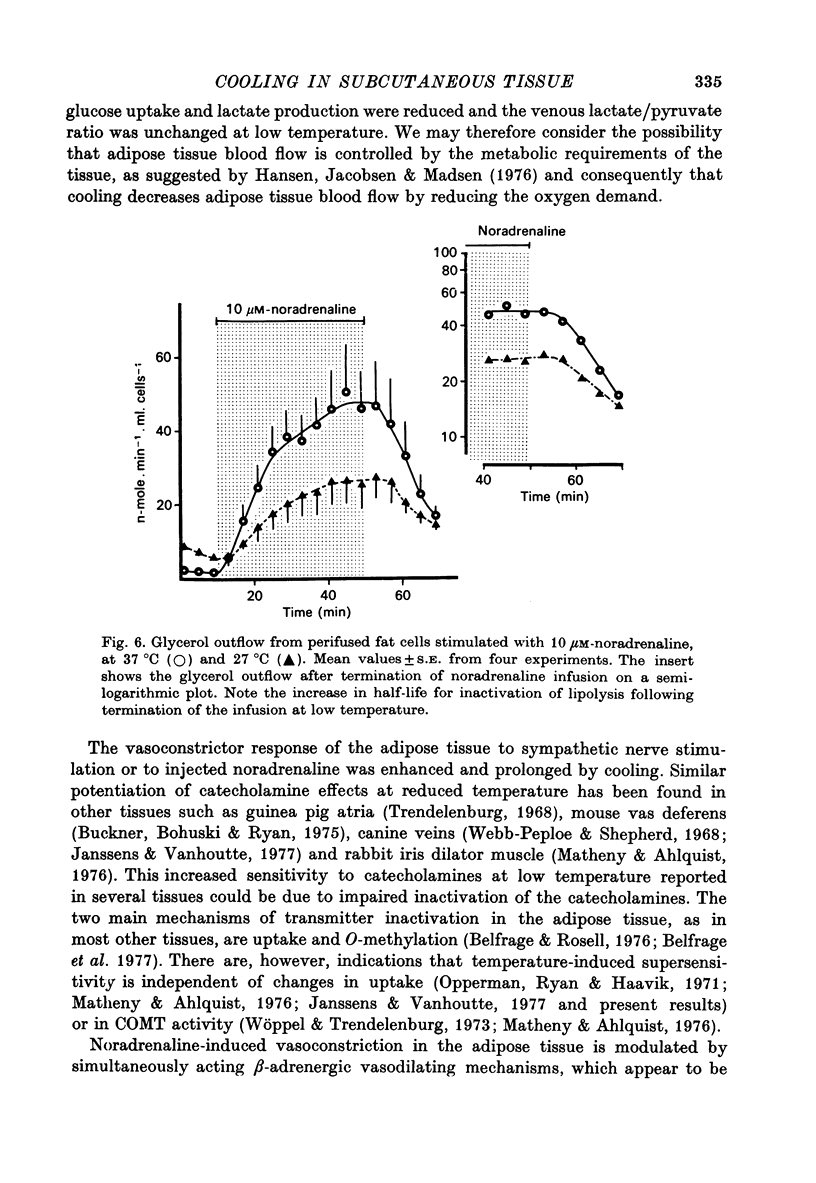
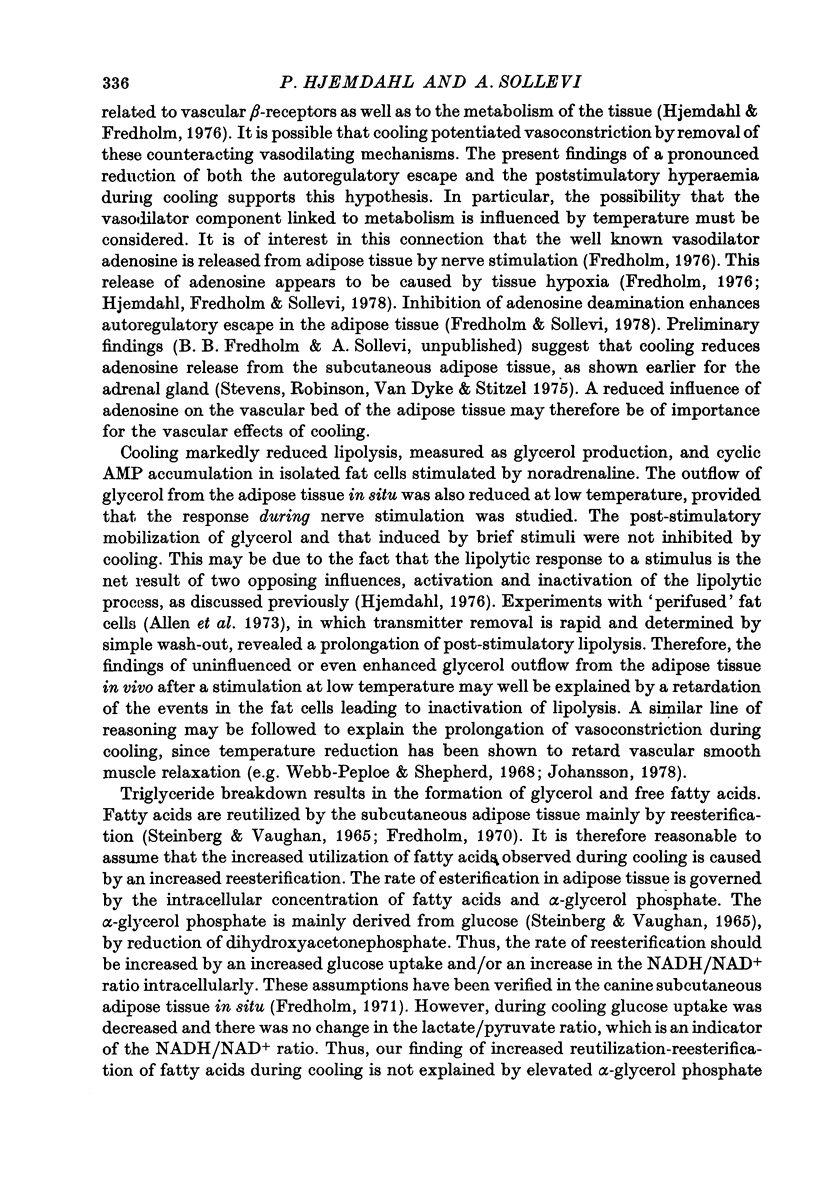
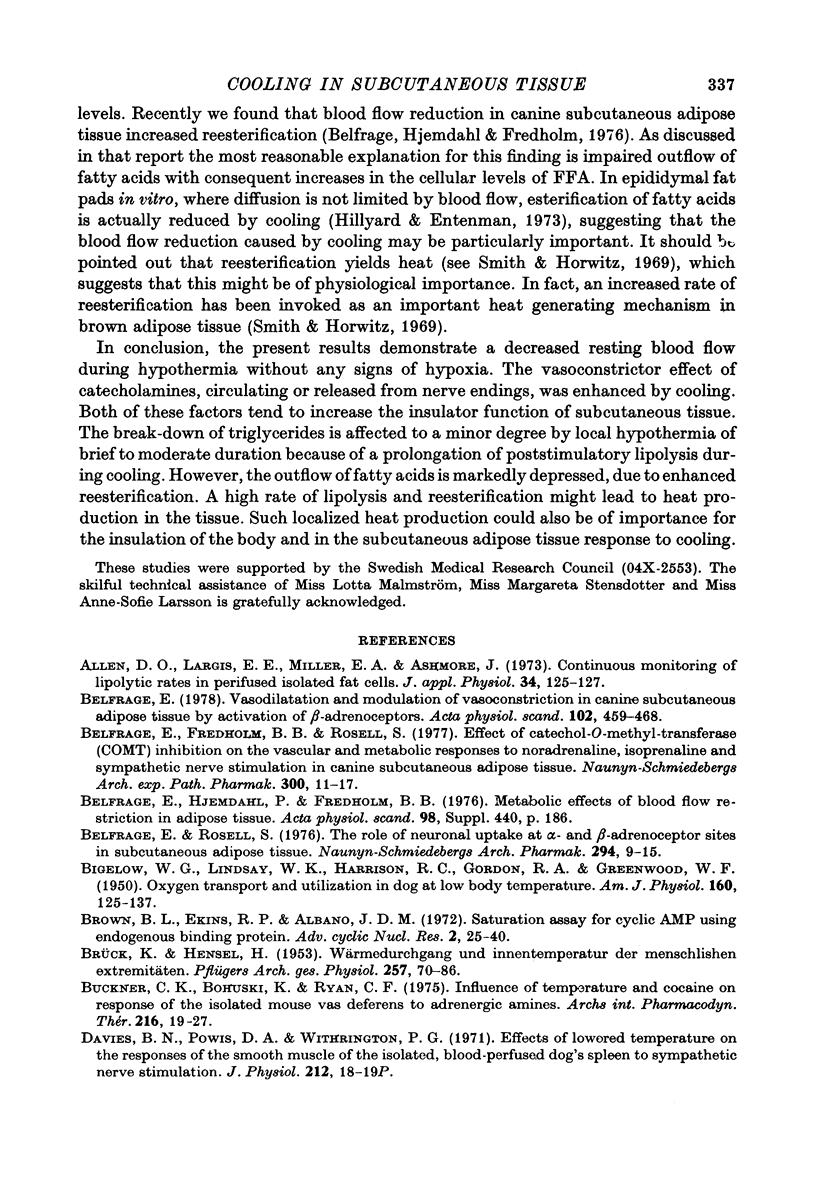
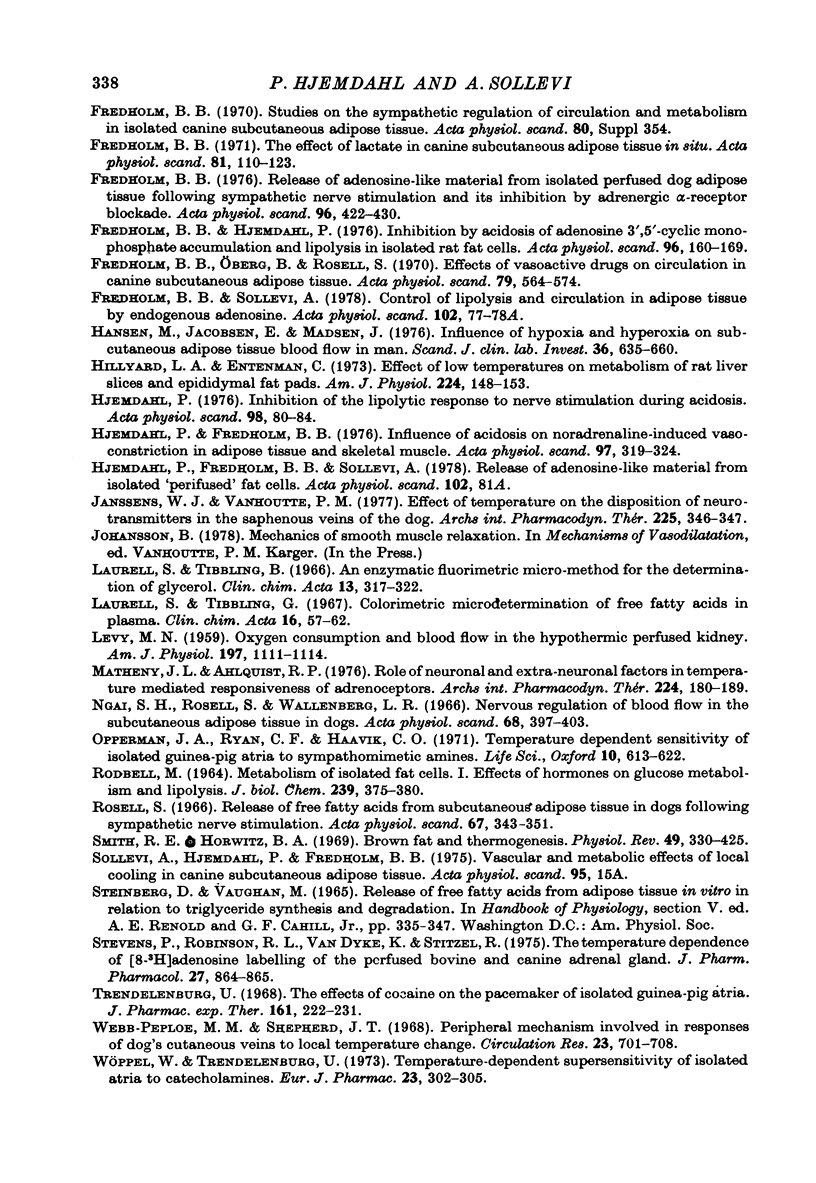
Selected References
These references are in PubMed. This may not be the complete list of references from this article.
- Allen D. O., Largis E. E., Miller E. A., Ashmore J. Continuous monitoring of lipolytic rates in perifused isolated fat cells. J Appl Physiol. 1973 Jan;34(1):125–127. doi: 10.1152/jappl.1973.34.1.125. [DOI] [PubMed] [Google Scholar]
- BIGELOW W. G., LINDSAY W. K. Oxygen transport and utilization in dogs at low body temperatures. Am J Physiol. 1950 Jan;160(1):125–137. doi: 10.1152/ajplegacy.1949.160.1.125. [DOI] [PubMed] [Google Scholar]
- BRUCK K., HENSEL H. Wärmedurchgang und Innentemperatur der menschlichen Extremitäten. Pflugers Arch. 1953;257(1):70–86. doi: 10.1007/BF00363412. [DOI] [PubMed] [Google Scholar]
- Belfrage E., Fredholm B. B., Rosell S. Effect of catechol-O-methyl-transferase (COMT) inhibition on the vascular and metabolic responses to noradrenaline, isoprenaline and sympathetic nerve stimulation in canine subcutaneous adipose tissue. Naunyn Schmiedebergs Arch Pharmacol. 1977 Oct;300(1):11–17. doi: 10.1007/BF00505074. [DOI] [PubMed] [Google Scholar]
- Belfrage E., Rosell S. The role of neuronal uptake at alpha- and beta-adrenoceptor sites in subcutaneous adipose tissue. Naunyn Schmiedebergs Arch Pharmacol. 1976 Jul;294(1):9–15. doi: 10.1007/BF00692779. [DOI] [PubMed] [Google Scholar]
- Belfrage E. Vasodilatation and modulation of vasoconstriction in canine subcutaneous adipose tissue caused by activation of beta-adrenoceptors. Acta Physiol Scand. 1978 Apr;102(4):459–468. doi: 10.1111/j.1748-1716.1978.tb06094.x. [DOI] [PubMed] [Google Scholar]
- Brown B. L., Ekins R. P., Albano J. D. Saturation assay for cyclic AMP using endogenous binding protein. Adv Cyclic Nucleotide Res. 1972;2:25–40. [PubMed] [Google Scholar]
- Buckner C. K., Bohuski K., Ryan C. F. Influence of temperature and cocaine on responses of the isolated mouse vas deferens to adrenergic amines. Arch Int Pharmacodyn Ther. 1975 Jul;216(1):19–27. [PubMed] [Google Scholar]
- Davies B. N., Powis D. A., Withrington P. G. Effects of lowered temperature on the responses of the smooth muscle of the isolated, blood-perfused dog's spleen to sympathetic nerve stimulation. J Physiol. 1971 Jan;212(2):18P–19P. [PMC free article] [PubMed] [Google Scholar]
- Fredholm B. B., Hjemdahl P. Inhibition by acidosis of adenosine 3',5'-cyclic monophosphate accumulation and lipolysis in isolated rat fat cells. Acta Physiol Scand. 1976 Feb;96(2):160–169. doi: 10.1111/j.1748-1716.1976.tb10185.x. [DOI] [PubMed] [Google Scholar]
- Fredholm B. B., Oberg B., Rosell S. Effects of vasoactive drugs on circulation in canine subcutaneous adipose tissue. Acta Physiol Scand. 1970 Aug;79(4):564–574. doi: 10.1111/j.1748-1716.1970.tb04759.x. [DOI] [PubMed] [Google Scholar]
- Fredholm B. B. The effect of lactate in canine subcutaneous adipose tissue in situ. Acta Physiol Scand. 1971 Jan;81(1):110–123. doi: 10.1111/j.1748-1716.1971.tb04881.x. [DOI] [PubMed] [Google Scholar]
- Hansen M., Jacobsen E., Madsen J. Influence of hypoxia and hyperoxia on subcutaneous adipose tissue blood flow in man. Scand J Clin Lab Invest. 1976 Nov;36(7):655–660. doi: 10.1080/00365517609054491. [DOI] [PubMed] [Google Scholar]
- Hillyard L. A., Entenman C. Effect of low temperature on metabolism of rat liver slices and epididymal fat pads. Am J Physiol. 1973 Jan;224(1):148–153. doi: 10.1152/ajplegacy.1973.224.1.148. [DOI] [PubMed] [Google Scholar]
- Hjemdahl P., Fredholm B. B. Influence of acidosis on noradrenaline-induced vasoconstriction in adipose tissue and skeletal muscle. Acta Physiol Scand. 1976 Jul;97(3):319–324. doi: 10.1111/j.1748-1716.1976.tb10269.x. [DOI] [PubMed] [Google Scholar]
- Hjemdahl P. Inhibition of the lipolytic response to nerve stimulation during acidosis. Acta Physiol Scand. 1976 Sep;98(1):80–84. doi: 10.1111/j.1748-1716.1976.tb10305.x. [DOI] [PubMed] [Google Scholar]
- Janssens W. J., Vanhoutte P. M. Effect of temperature on the disposition of neurotransmitters in the saphenous veins of the dog. Arch Int Pharmacodyn Ther. 1977 Apr;226(2):346–347. [PubMed] [Google Scholar]
- LEVY M. N. Oxygen consumption and blood flow in the hypothermic, perfused kidney. Am J Physiol. 1959 Nov;197:1111–1114. doi: 10.1152/ajplegacy.1959.197.5.1111. [DOI] [PubMed] [Google Scholar]
- Laurell S., Tibbling G. An enzymatic fluorometric micromethod for the determination of glycerol. Clin Chim Acta. 1966 Mar;13(3):317–322. doi: 10.1016/0009-8981(66)90210-5. [DOI] [PubMed] [Google Scholar]
- Laurell S., Tibbling G. Colorimetric micro-determination of free fatty acids in plasma. Clin Chim Acta. 1967 Apr;16(1):57–62. doi: 10.1016/0009-8981(67)90269-0. [DOI] [PubMed] [Google Scholar]
- Matheny J. L., Ahlquist R. P. Role of neuronal and extraneuronal factors in temperature mediated responsiveness of adrenoceptors. Arch Int Pharmacodyn Ther. 1976 Dec;224(2):180–189. [PubMed] [Google Scholar]
- Oppermann J. A., Ryan C. F., Haavik C. O. Temperature dependent sensitivity of isolated guinea-pig atria to sympathomimetic amines. Life Sci I. 1971 Jun 1;10(11):613–622. doi: 10.1016/0024-3205(71)90282-7. [DOI] [PubMed] [Google Scholar]
- RODBELL M. METABOLISM OF ISOLATED FAT CELLS. I. EFFECTS OF HORMONES ON GLUCOSE METABOLISM AND LIPOLYSIS. J Biol Chem. 1964 Feb;239:375–380. [PubMed] [Google Scholar]
- Rosell S. Release of free fatty acids from subcutaneous adipose tissue in dogs following sympathetic nerve stimulation. Acta Physiol Scand. 1966 Jul-Aug;67(3):343–351. doi: 10.1111/j.1748-1716.1966.tb03320.x. [DOI] [PubMed] [Google Scholar]
- Smith R. E., Horwitz B. A. Brown fat and thermogenesis. Physiol Rev. 1969 Apr;49(2):330–425. doi: 10.1152/physrev.1969.49.2.330. [DOI] [PubMed] [Google Scholar]
- Stevens P., Robinson R. L., Van Dyke K., Stitzel R. The temperature dependence of [8-3H]adenosine labelling of the perfused bovine and canine adrenal gland. J Pharm Pharmacol. 1975 Nov;27(11):864–865. doi: 10.1111/j.2042-7158.1975.tb10232.x. [DOI] [PubMed] [Google Scholar]
- Trendelenburg U. The effect of cocaine on the pacemaker of isolated guinea-pig atria. J Pharmacol Exp Ther. 1968 Jun;161(2):222–231. [PubMed] [Google Scholar]
- Webb-Peploe M. M., Shepherd J. T. Peripheral mechanism involved in response of dog's cutaneous veins to local temperature change. Circ Res. 1968 Dec;23(6):701–708. doi: 10.1161/01.res.23.6.701. [DOI] [PubMed] [Google Scholar]
- Wöppel W., Trendelenburg U. Temperature-dependent supersensitivity of isolated atria to catecholamines. Eur J Pharmacol. 1973 Sep;23(3):302–305. doi: 10.1016/0014-2999(73)90100-3. [DOI] [PubMed] [Google Scholar]


